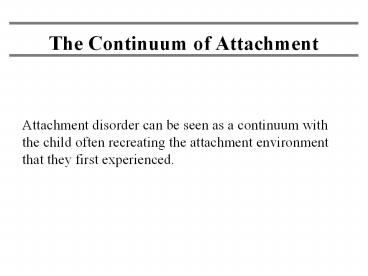The%20Continuum%20of%20Attachment - PowerPoint PPT Presentation
Title:
The%20Continuum%20of%20Attachment
Description:
The Continuum of Attachment Attachment disorder can be seen as a continuum with the child often recreating the attachment environment that they first experienced. – PowerPoint PPT presentation
Number of Views:286
Avg rating:3.0/5.0
Title: The%20Continuum%20of%20Attachment
1
The Continuum of Attachment
- Attachment disorder can be seen as a continuum
with the child often recreating the attachment
environment that they first experienced.
2
Secure Attachment
- Secure attachments provide safety and protection,
teaching basic trust and reciprocity. Secure
attachment is the basis for self-esteem and
self-concept. It promotes socialization,
facilitates development of morality, empathy,
conscience, creates a positive "inner working
model", promotes health and physical development
and increases resiliency. - Seek primary care giver when distressed
- Easily comforted
- Absorbed play
- Curious
- Responsive to environment cues
- Reciprocity in relationships
- Use care giver as a secure base from
which to explore
3
Insecure-Anxious Attachment Disorder
- May result from a dysfunctional attachment during
the early years. There may have been some
attachment to a caretaker but it may have been
inconsistent, or abusive. - Charming, superficial
- Appear emotionally empty
- Eager to please, chameleons, (hyper
vigilant) - Bossy, demanding of affection and
attention - Intrusive into others space
- Clingy and dependent
- Whines and pouts when limits set
- May hurt adult when being affectionate,
or be seductive - Lie, steal and hoard
- Buy friendships
- Manipulate, manipulate, manipulate
4
Insecure-Avoidant Attachment
- Probably caused by a neglectful environment. Make
themselves very hard to like-which fulfills their
belief about themselves and the world-that they
deserved rejection. - Avoid close relationships, loners,
distant - Self-reliant, believe they can meet
their own needs - Rarely distressed when caregiver leaves
- May reject caregiver following
separation - Feel safe when in control
- Do not seek out friends
- Hostile, passive-aggressive
- Avoid eye contact
- Chatter nonstop, ask nonsense questions
- Annoying behaviors that keep others at
a distance - Avoid feelings, may have flat affect or
fake emotions - Low self-esteem
- When held, complain, wiggle or itch
5
Insecure-Ambivalent Attachment
- Probably caused by an abusive early environment
or one which was both abusive and neglectful with
little predictability. - Openly angry and defiant and destructive
especially when limits set - Distressed during separation, difficult
to comfort - Seeks contact yet may be angry and
resist closeness upon return - Destructive to self, others, animals and
property - Sneaky
- Lie and steal
- Superficial and manipulative to get what
they want - Stiffen in response to affection
- Sabotages closeness
- When stressed appears disorganized
- Regresses or acts immature when needing
affection - Lack of remorse
- Obsessed with fire, blood and gore.
6
Disorganized Attachment
- May have experienced a very chaotic environment
in early years. May have experienced both
nurturing and abuse - Concurrent psychological disorders
- Odd, bizarre behavior
- Unpredictable, excitable, changeable
- Unable to maintain consistent attachment
strategy when distressed - Go from crisis to crisis
- Behavior marked by conflicting drives to
approach and avoid - Sudden bursts of anger followed by
sudden freezing or dazed behavior - May dissociate memory of abuse to
maintain attachment
7
Children with Attachment Disorder Have Often
Experienced
- Abuse (physical, emotional, sexual)
- Neglect
- Prolonged separation from primary caretaker
- Undiagnosed and/or painful illnesses
- Frequent moves and/or placements
- Inconsistent or inadequate daycare
- Chronic maternal depression
- Poor parenting skills
- Separation due to death or divorce
- Prenatal injuries
- Organic or neurological insults
8
Behaviors
- Superficially engaging and charming behavior
- Indiscriminate affection toward
strangers-affection on their terms only - Lack of eye contact
- Persistent nonsense questions and incessant
chatter - Inappropriate demanding and clingy behavior
- Chronic, crazy lying
- Stealing
- Destructive of self, others and property
- Sexualized behavior
- Abnormal eating patterns
- Problems with impulse controls
- Learning lags and disorders
- Abnormal speech patterns
- Poor peer relationships
- Lack of cause and effect thinking
- Lack of guilt or remorse
- Cruelty to animals
9
Associated Behaviors
10
Hierarchy of Brain Function
- Abstract thought
- Concrete thought
- Affiliation
- Attachment
- Sexual behavior
- Emotional reactivity
- Motor regulation
- Arousal
- Appetite/Satiety
- Sleep
- Blood pressure
- Heart rate
- Body temperature
- Cortical
- Most Complex
- Most cells
- Develops later
- Limbic
- Midbrain
- Least Complex
- Fewer cells
- Develops earlier
- Brainstem
11
Role of Amygdala
- Sensory Cortex
- Amygdala
- Sensory
- Thalamus
- AD Reaction
- Emotional Response
- Emotional Stimulus
12
Assessment
- History
- Discovering What the Parents Know
- Testing
- Observation
- Behavior
13
Attachment and Attunement
- Attunement Lack of Attunement
- Supports making sense of experience No help
making sense of experience - Enhances emotional regulation Overwhelming
emotions - Gives coherent narrative Incoherent narrative
- Supports language development Impaired language
development - Supports sense of self Dysfunctional sense of
self - Increases capacity to plan and inhibit Decreased
ability to plan and inhibit
14
Attachment Behaviors Daily Checklist
Check the behaviors you observed today
________________ (date).
____Accepts redirection, parental
limits. ____Able to play independently but
returns to parent to re-energize. ____Able to
delay gratification for increasing periods of
time. ____Exhibits feelings other than mad, such
as sadness, fear, happiness. ____Enjoys
games, time spent with parent. ____Smiles
and makes eye contact for increasing length of
time. ____Accepts cuddling or physical
contact. ____Initiates physical
contact. ____Allows parent to comfort them when
distressed. ____Has been fun to be
around today.
15
(No Transcript)































